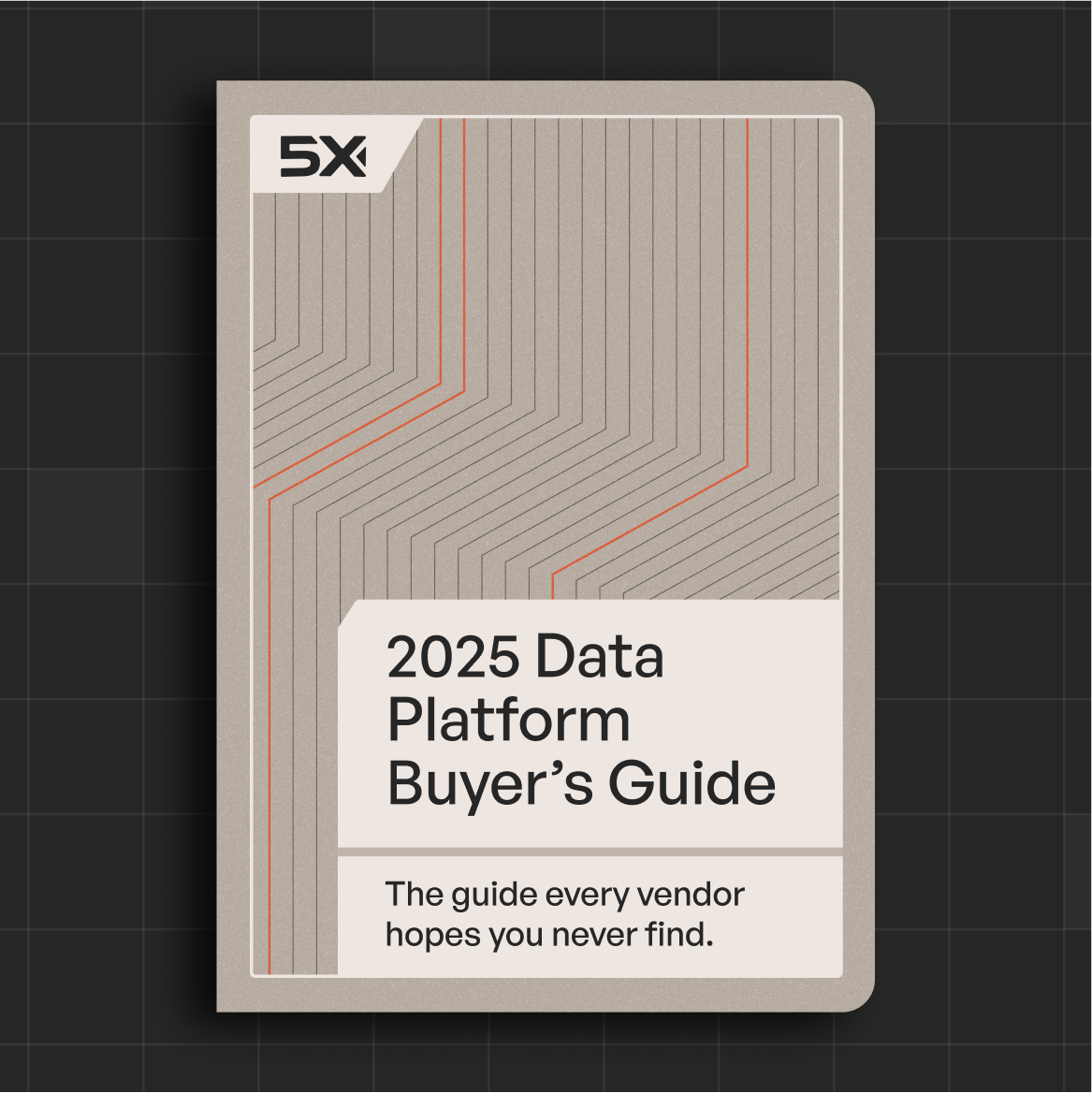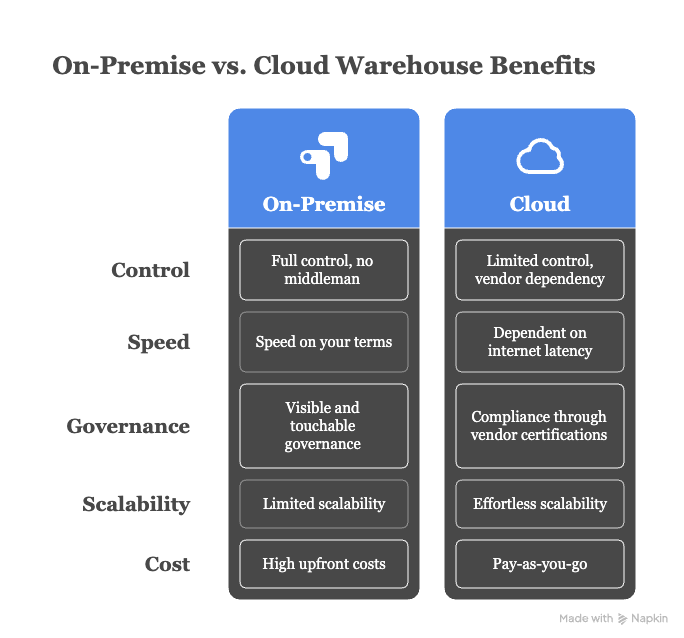On-premises vs. cloud data warehouses: Pros, cons, and what’s right for your business


.png)
Table of Contents
TL; DR
- On-premise is ideal for regulated industries needing strict data control
- Cloud is best for fast-growing, data-driven teams needing agility
- On-premise setups deliver low latency but limited scalability
- Cloud based warehouses integrates easily with AI and BI tools
- Choosing the right warehouse impacts data quality and business efficiency
- On-premise gives you control and cloud gives you freedom. Choose based on your goals.
Your dashboards are lagging. Queries take forever. And every time your team asks for “just one more data source,” IT groans. Sound familiar?
For years, companies built massive on-premise data warehouses with their servers humming in climate-controlled rooms, because that’s what data reliability looked like. But the game has changed.
As cloud computing matured, the question isn’t whether you should move to the cloud, but why you haven’t yet. Cloud data warehouses now offer elastic scaling, faster insights, and built-in intelligence, all without the hardware headaches. Still, the choice isn’t always obvious. Between strict regulations, cost concerns, and migration headaches, finding what’s right for your business can be tricky.
In this blog, we’ll break down the pros, cons, and trade-offs between on-premise and cloud data warehouses, so you can make the right choice for your business.
What are on-premise data warehouses?
On-premise data warehouses are physical servers hosted and managed within your organization’s infrastructure. You own the hardware, control the configurations, and maintain full responsibility for setup, upgrades, and security. This setup gives you complete control over performance, governance, and compliance, making it ideal for industries with strict data regulations.
What are cloud-based data warehouses?
Cloud-based data warehouses live on remote, vendor-managed infrastructure like AWS, Google Cloud, or Azure. They let you store, manage, and analyze massive datasets without owning physical hardware. These warehouses often come with built-in tools for analytics, governance, and security, making them ideal for modern, data-driven teams.
Key differences between cloud data warehouse vs on-premise data warehouse:
On-premise warehouses give you complete control. You own the infrastructure, decide how it’s configured, and dictate performance standards. That’s why some industries like finance or government still prefer it as tighter control helps meet strict regulatory and data residency requirements. Plus, with everything running locally, latency can be low and predictable.
On the other hand, cloud data warehouses flip that model to give you on-demand scalability. They’re cost-efficient because you pay only for what you use. Most modern platforms like Snowflake, BigQuery, and 5X bundle in security, access control, monitoring, and analytics, so your teams can focus on using data instead of managing it.
In short, on-premise gives you control, but the cloud gives you freedom.
Why is choosing the right data warehouse important?
Picking the right data warehouse isn’t just a tech decision as your business depends on it. It’s the foundation of every insight, decision, and strategy your company makes. The right choice helps you scale confidently, move faster, and make smarter calls. The wrong one? It can leave you with broken dashboards, bad data, and wasted budgets.
Here’s why choosing the right warehouse matters:
- Better decisions, backed by data: A solid warehouse brings all your data together so leaders can make informed, confident choices instead of relying on gut instinct
- High data quality, zero confusion: It cleans, standardizes, and centralizes data, giving teams one source of truth minus the hassle of mismatched reports
- Faster performance: When queries run faster, insights come quicker. That means less waiting and more doing
- Built to grow: The right warehouse scales as you do as there are no painful migrations or downtime when data volumes spike
- Saves time and money: Choosing smart upfront prevents costly rework, endless maintenance, and bad business decisions later
- Streamlined operations: With data unified in one place, teams spend less time chasing numbers and more time driving outcomes
On-premise VS cloud data warehouse: What are the benefits?

Choosing between on-premise and cloud data warehouses isn’t just about where your data lives, it’s about how your business runs. Here’s a breakdown of the pros and cons:
1. Benefits of using an on-premise data warehouse
Going on-premise isn’t for the faint-hearted. But for the right organization, it’s still a powerful choice.
Here’s why:
- Full control, no middleman: With on-premise data warehouses, you call the shots. You decide the hardware you buy and who is authorized to touch the servers. If something breaks, your IT team doesn’t have to wait for a cloud vendor to respond. They can walk right up to the rack, swap parts, and reboot within minutes. For organizations that prioritize autonomy and want total visibility into their stack, that’s priceless
- Speed on your terms: Because everything runs locally, you are not at the mercy of internet latency or shared cloud bandwidth. That’s a big deal for workloads that can’t afford a lag
- Governance you can see and touch: If you’re in a heavily regulated industry like banking, healthcare, or government, knowing exactly where your data sits matters. On-premise makes compliance with data privacy laws like GDPR simpler because you have physical control over data location and access
2. Benefits of using a cloud data warehouse
If on-prem is all about control, the cloud is all about freedom — freedom to scale, experiment, and innovate without worrying about hardware, downtime, or server space. That’s why most modern data-driven businesses are moving their warehouses to the cloud. Here’s why it works:
- Effortless scalability: Traffic spikes? New data streams? No problem. Cloud warehouses like Snowflake or BigQuery automatically scale up or down based on your workload. You don’t have to forecast hardware needs or overpay for idle capacity as the system grows with you
- Pay only for what you use: Forget massive upfront costs. With the cloud, you pay by usage for storage and compute hours. Plus, the provider handles the maintenance, upgrades, and infrastructure, freeing your team to focus on insights, not server logs
- Plug into an ecosystem: Cloud warehouses sit within powerful ecosystems. Want identity management, AI analytics, or advanced monitoring? They seamlessly integrate with AI and BI tools, thereby allowing businesses to focus on insights instead of infrastructure
- Built-in security and reliability: Yes, security is a concern but ironically, hyperscalers are often more secure than in-house setups. With compliance standards like ISO 27001 and SOC 2, your data is protected 24/7, backed by global redundancy and 99.9% uptime guarantees
- Faster time to insight: No setup delays. No patching cycles. Cloud data warehouses let you go from setup to insights in hours, not weeks, thereby accelerating product launches and decision-making across the board
On-premise VS cloud data warehouse: What are the disadvantages?

Making the right decision between on-premise and cloud warehouses also means carefully considering the disadvantages too. Here’s a quick breakdown of how both might fail you:
1. Cons of using an on-premise data warehouse
Running your own data warehouse sounds empowering — until you realize just how much time, talent, and money it actually takes to keep the lights on. Here’s what usually trips teams up:
- High upfront and ongoing costs: Building an on-premise warehouse isn’t just about buying servers. It’s as much about the whole ecosystem: racks, cooling systems, backup power, and the physical space to house it. As a result, your “one-time setup” turns into a long-term investment that keeps billing you every year in the form of periodic hardware refreshes and software licenses renewal
- Heavy dependence on in-house support: An on-premise system doesn’t maintain itself. You’ll need a dedicated team of administrators, engineers, and analysts to monitor performance, apply patches, and fix outages. That’s not just payroll — it’s constant coordination between teams to keep the system secure, fast, and compliant
- Limited scalability: Scaling on-premise infrastructure isn’t a few clicks, it’s a project. If your business suddenly spikes in traffic or data, you can’t just “add capacity.” You’ll need new hardware, procurement approvals, installation time, and possibly downtime. And if that spike was temporary, you’re stuck paying for idle servers that no longer serve your needs
2. Cons of using a cloud data warehouse
Considering its benefits, cloud warehouses still come with a lot of challenges.
- Integration takes effort: You’ll need ETL or ELT pipelines to bring in data, which can get complex without the right tools
- Vendor lock-in: Moving from one provider to another can be challenging to execute both technically and contractually
- Latency: Real-time data is hard to make sense of if your sources are distributed globally
- Setup is crucial: While the cloud offers agility and scale, you’ll need the right setup and partner tools to truly make it effective
Modernize your data warehouse smartly with 5X
The debate between on-premise and cloud data warehouses often misses the point. It’s not just about where your data lives, but how easily your business can use it. That’s where 5X comes in.
5X is a modern data platform purpose-built for teams who want the flexibility of the cloud without getting locked into a single vendor or juggling complex infrastructure.
Instead of forcing you to choose between control and convenience, 5X gives you both. You get a fully managed, modular data stack that lets you plug in best-in-class tools while 5X handles deployment, governance, and cost optimization in the background.
In other words, 5X gives you cloud-scale performance with on-premise-level governance minus the manual setup, endless vendor negotiations, or runaway costs. Your engineers focus on insights, not infrastructure. Your finance team gets predictable pricing. And your data stays clean, compliant, and always ready for business use.
Whether you’re modernizing an existing on-premise setup or starting fresh in the cloud, 5X helps you move faster, stay flexible, and future-proof your data warehouse strategy.
FAQs
What is the difference between cloud and on-prem data warehouses?

What are some examples of traditional data warehouses?

What are the 4 stages of data warehousing?

What are the 5 warehouse processes?

Building a data platform doesn’t have to be hectic. Spending over four months and 20% dev time just to set up your data platform is ridiculous. Make 5X your data partner with faster setups, lower upfront costs, and 0% dev time. Let your data engineering team focus on actioning insights, not building infrastructure ;)
Book a free consultationHere are some next steps you can take:
- Want to see it in action? Request a free demo.
- Want more guidance on using Preset via 5X? Explore our Help Docs.
- Ready to consolidate your data pipeline? Chat with us now.
Get notified when a new article is released

How retail leaders unlock hidden profits and 10% margins
Retailers are sitting on untapped profit opportunities—through pricing, inventory, and procurement. Find out how to uncover these hidden gains in our free webinar.
Save your spot






%201.svg)

.png)
.png)






